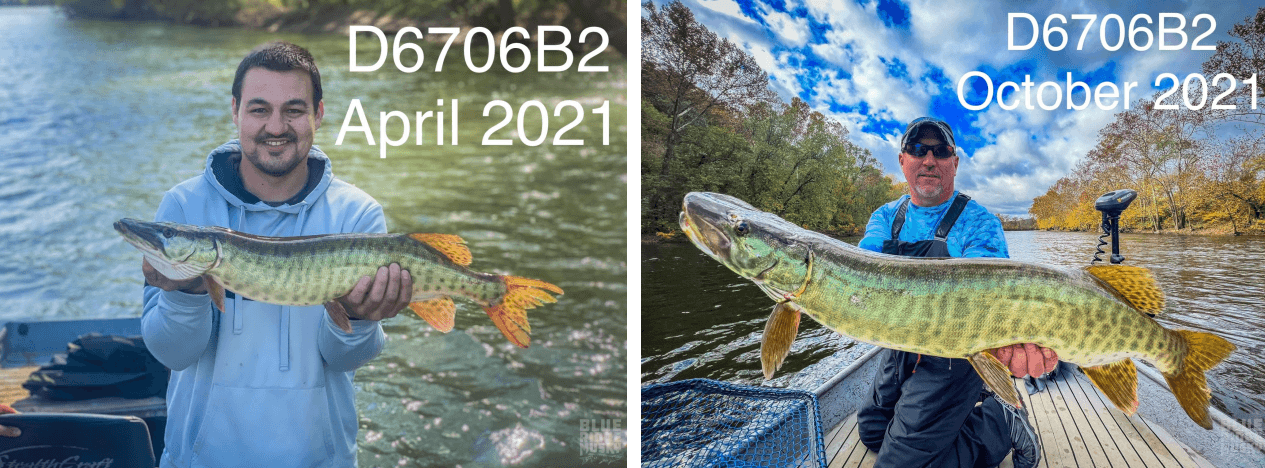With profound knowledge comes profound respect. Sam Scott of Blue Ridge Musky guide service grew up fishing the rivers of Virginia — catching fish that he, unknowingly, would help tag and research years down the line. Learn more about musky and the citizen science tracking their movements in this article.

This article covers:
The Mighty Musky
words and imagery courtesy of Sam Scott
My name is Sam Scott, and I’ve lived in Blue Ridge, Virginia my whole life — floating its rivers, fishing its streams, and chasing its game fish. Out of all those fish, there’s one that stands alone as top dog in these waters. The Virginia muskellunge, musky, or muskie, is the apex predator in the freshwater rivers of Appalachia, and is also my life’s passion.

Musky Tagging with Virginia DWR
As I first got my start guiding for musky, my friend, Tyler Young, was spearheading our state’s musky research program at the Department of Wildlife and Resources (DWR). We soon began working together to learn more about our muskies here in Virginia. Our healthy musky fisheries present an ideal place to conduct studies on the species. Tyler and I have been working together ever since the beginning. I’ve been guiding him through the rivers, showing him where the largest concentrations of muskies are, and he’s been getting me involved with the conservation studies. I’ve participated in electroshocking studies, brood stock harvesting, community engagement, and helped the DWR produce a how to video for new anglers looking to safely and ethically target musky in the commonwealth.

As my fascination with these fish increased with each day on the water, I sought licensing from the Virginia Department of Wildlife and Resources to start tagging fish on my own. I soon began scanning and implanting the fish I caught with a ‘Passive Integrated Transponder’, or PIT tag. Each tag has a sequence of numbers and letters unique to that fish. To date, I’ve been able to help collect data spanning 80 miles of river on roughly 600 specimens, and have tagged another 200 new muskies into the database.
Learning from the Data
At the end of each week of fishing, I got into the habit of reviewing and studying the data I had collected. Being able to track a fish’s growth and their movements from capture to recapture changed the way I looked at muskies. I started noticing patterns of movement, some incredible growth rates, and certain fish that seemed to find their way into my net more often than others.

In April of 2021, I tagged D6706B2 at 26 inches long. Six months later in October, we recaptured this fish — in the same spot — at 34 inches long. 8 inches in 6 months is still the most impressive growth rate I’ve recorded on any musky specimen. It’s incredible to think of what this fish could look like down the line, in my own net or perhaps one of another angler. In another great example of musky growth — C014147 and I were first acquainted in 2018 on Thanksgiving Day when my client caught her at a healthy 47 inches. I struggled to relocate this fish for some time. Not until this past winter, almost five years later, did my client hook into an absolute brute in a long, deep pool. She had migrated 5 miles upriver and had grown into a massive 49.5 inch giant. Each fish — its habits, growth rates, migration patterns — is unique, and understanding each fish’s story helps to contribute to our understanding of the Virginia musky as a whole.

While the last specimen was able to evade my capture for 5 years, there are other muskies, much more aggressive muskies, that seem to find their way into my net every 5 months. Take for instance BFEEBAC, a 40 inch male. This specimen was originally tagged by the DWR in 2017. Between 2018 and 2022, we landed this fish 7 times. Such fish are prime examples of how catch and release, when paired with proper handling practices, can succeed in sustaining musky populations for future anglers. It is also one of our most important tools in our study of the species.

Despite our state's research, there’s not a lot known about musky when compared to other species of fish. New behaviors are constantly observed across the state and throughout the country. Biologically, we are only scratching the surface. As a southern state, and one of the warmest climates inhabited by muskies, Virginia has the important responsibility of continuing to study how these fish adapt to and are affected by the warmer climate. As a part of DWR’s progressive muskie program, I continue to study and understand the fish as we work together towards improving their survivability in warmer climates to come.
Sam Scott lives in Blue Ridge, Virginia, and is the owner/operator of Blue Ridge Musky guide service.
Musky Conservation FAQ
What is AnyCreek?
AnyCreek is the leading online resource and marketplace for outdoor guided experiences. Trusted by world-class guides, AnyCreek streamlines their back office to help them focus on their craft. Discover and book your next adventure with confidence.